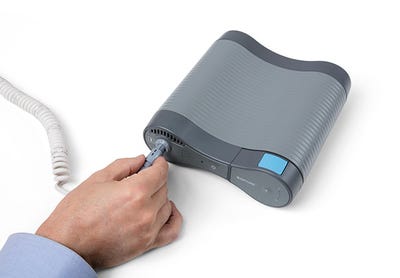April 13, 2017
A European study of Novocure's tumor-treating fields technology yielded encouraging results for patients with a deadly cancer.
Nancy Crotti

A recent small study of low-intensity, alternating electric fields in treating pancreatic cancer suggests longer survival times.
Novocure (St. Helier, Jersey) recently completed a feasibility, safety, and preliminary efficacy pilot study of its tumor-treating fields (TTFields) technology in 40 patients with advanced pancreatic cancer. Half of the patients had were treated with TTF and the chemotherapy drugs nab-pacitaxe and gemcitabine, while the other half received the drugs alone, according to Uri Weinberg, MD PhD, vice president of research and development for the company.
The median survival rate of trial participants who were treated with a combination of TTF and the drugs and whose cancer did not progress was 12.7 months. That compares with a median 5.5-month survival rate among patients treated with the drugs alone, according to a statement from Novocure. Forty percent of the evaluable tumors had partial responses, compared to 23% with treated with the nab-paclitaxel plus gemcitabine drug combination alone. Another 47% of the TTFields group had stable disease compared to 27% who received drugs only. No serious side effects were reported.
Pancreatic cancer has the lowest surival rate of all major cancers, with just 2% to 10% of those diagnosed surviving for five years, according to the World Pancreatic Cancer Coalition. By 2020, the number of new cases is expected to reach 418,000.
Patients and caregivers can administer Novocure electric wave treatment using the company's Optune device. Optune uses adhesive patches, called transducer arrays, to deliver therapy that can slow or stop cancer cells from dividing. These transducer arrays are applied to the skin based on each patient's MRI results, according to Optune website. FDA approved Optune to treat recurrent glioblastoma in 2014 and newly diagnosed glioblastoma the following year. Its main side effects are skin irritation and headache, according to the company.
All 40 patients in the recent PANOVA trial, conducted in Spain and Switzerland, had locally advanced or metastasized pancreatic cancer.The trial's primary endpoint was to determine the toxicity of TTFields compared to historical results, Weinberg said in a phone interview. Other than skin irritation, which occurred in half the patients, there were no serious side effects, he said.
Trial results were presented recently at the American Association for Cancer Research's annual meeting in Washington.
PANOVA was the first such trial conducted in humans with pancreatic cancer, which is usually diagnosed at late stages. The trial's results encouraged the company to plan a Phase III randomized trial in Europe and North America to measure the efficacy of TTFields therapy in pancreatic cancer patients. The company anticipates it will enroll the first patient in the second half of 2017 with data available for presentation roughly 18 months after the last patient is enrolled.
"It enables us to use it alongside other therapies and at advanced stages to add to the efficacy of those treatments, improve patient survival time and decrease symptoms of cancer without getting toxicity and without damaging quality of life. This is our goal," Weinstein said. "It has been demonstrated in glioblastoma that the addition of Optune does not cause any decline in the quality of life."
About the Author(s)
You May Also Like


